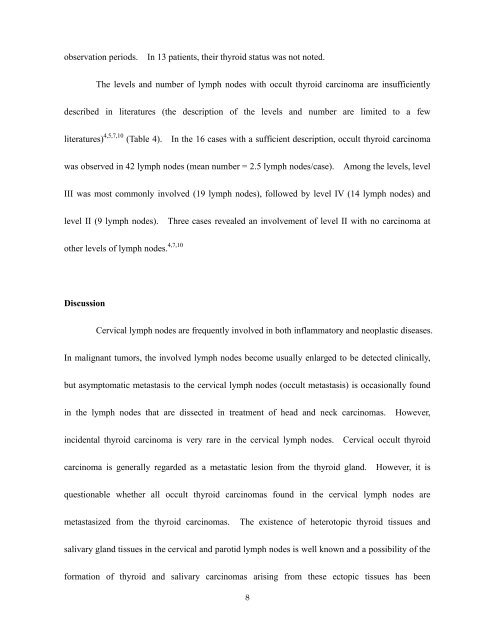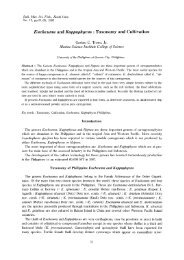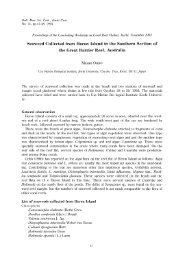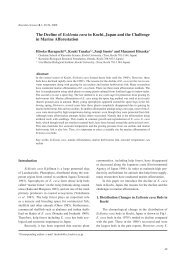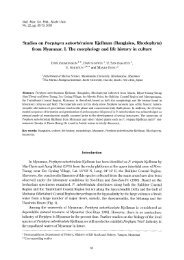Thyroid carcinomas incidentally found in the cervical lymph nodes ...
Thyroid carcinomas incidentally found in the cervical lymph nodes ...
Thyroid carcinomas incidentally found in the cervical lymph nodes ...
You also want an ePaper? Increase the reach of your titles
YUMPU automatically turns print PDFs into web optimized ePapers that Google loves.
observation periods.In 13 patients, <strong>the</strong>ir thyroid status was not noted.The levels and number of <strong>lymph</strong> <strong>nodes</strong> with occult thyroid carc<strong>in</strong>oma are <strong>in</strong>sufficientlydescribed <strong>in</strong> literatures (<strong>the</strong> description of <strong>the</strong> levels and number are limited to a fewliteratures) 4,5,7,10 (Table 4). In <strong>the</strong> 16 cases with a sufficient description, occult thyroid carc<strong>in</strong>omawas observed <strong>in</strong> 42 <strong>lymph</strong> <strong>nodes</strong> (mean number = 2.5 <strong>lymph</strong> <strong>nodes</strong>/case). Among <strong>the</strong> levels, levelIII was most commonly <strong>in</strong>volved (19 <strong>lymph</strong> <strong>nodes</strong>), followed by level IV (14 <strong>lymph</strong> <strong>nodes</strong>) andlevel II (9 <strong>lymph</strong> <strong>nodes</strong>).Three cases revealed an <strong>in</strong>volvement of level II with no carc<strong>in</strong>oma ato<strong>the</strong>r levels of <strong>lymph</strong> <strong>nodes</strong>. 4,7,10DiscussionCervical <strong>lymph</strong> <strong>nodes</strong> are frequently <strong>in</strong>volved <strong>in</strong> both <strong>in</strong>flammatory and neoplastic diseases.In malignant tumors, <strong>the</strong> <strong>in</strong>volved <strong>lymph</strong> <strong>nodes</strong> become usually enlarged to be detected cl<strong>in</strong>ically,but asymptomatic metastasis to <strong>the</strong> <strong>cervical</strong> <strong>lymph</strong> <strong>nodes</strong> (occult metastasis) is occasionally <strong>found</strong><strong>in</strong> <strong>the</strong> <strong>lymph</strong> <strong>nodes</strong> that are dissected <strong>in</strong> treatment of head and neck <strong>carc<strong>in</strong>omas</strong>.However,<strong>in</strong>cidental thyroid carc<strong>in</strong>oma is very rare <strong>in</strong> <strong>the</strong> <strong>cervical</strong> <strong>lymph</strong> <strong>nodes</strong>. Cervical occult thyroidcarc<strong>in</strong>oma is generally regarded as a metastatic lesion from <strong>the</strong> thyroid gland.However, it isquestionable whe<strong>the</strong>r all occult thyroid <strong>carc<strong>in</strong>omas</strong> <strong>found</strong> <strong>in</strong> <strong>the</strong> <strong>cervical</strong> <strong>lymph</strong> <strong>nodes</strong> aremetastasized from <strong>the</strong> thyroid <strong>carc<strong>in</strong>omas</strong>.The existence of heterotopic thyroid tissues andsalivary gland tissues <strong>in</strong> <strong>the</strong> <strong>cervical</strong> and parotid <strong>lymph</strong> <strong>nodes</strong> is well known and a possibility of <strong>the</strong>formation of thyroid and salivary <strong>carc<strong>in</strong>omas</strong> aris<strong>in</strong>g from <strong>the</strong>se ectopic tissues has been8


